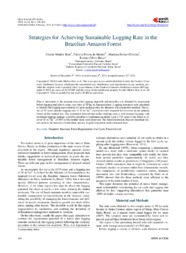Strategies for achieving sustainable logging rate in the Brazilian Amazon Forest.
Strategies for achieving sustainable logging rate in the Brazilian Amazon Forest.
Author(s): BRAZ, E. M.; MATTOS, P. P. de
Summary: Data of increment of the remnant trees after logging, ingrowth and mortality was obtained by assessment before logging and after 6 years, two sites of 50 ha, in Amazon forest. Logging scenarios were simulated to identify the logging rate potential for each studying sites, by diameter class projection method. The cy- cle of 35 years and the logging rate of 30 m3?ha?1 exceed the time required for recovery in the primary forest, in the studied site. The simulation showed that in the studying area, a well-planned logging, with minimum logging damage would be possible to implement an initial cycle of 25 years to the forest to re- cover 30 m3?ha?1, if 50% of the timber stock were reserved. The forest increment, beyond important fac- tors such as the increase of individual species, is quite dependent on the remnant trees.
Publication year: 2014
Types of publication: Journal article
Unit: Embrapa Forestry
Observation
Some of Embrapa's publications are published as ePub files. To read them, use or download one of the following free software options to your computer or mobile device. Android: Google Play Books; IOS: iBooks; Windows and Linux: Calibre.
Access other publications
Access the Agricultural Research Database (BDPA) to consult Embrapa's full library collection and records.
Visit Embrapa Bookstore to purchase books and other publications sold by Embrapa.

